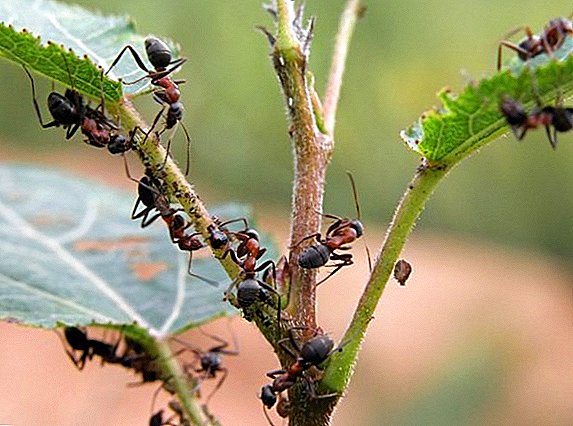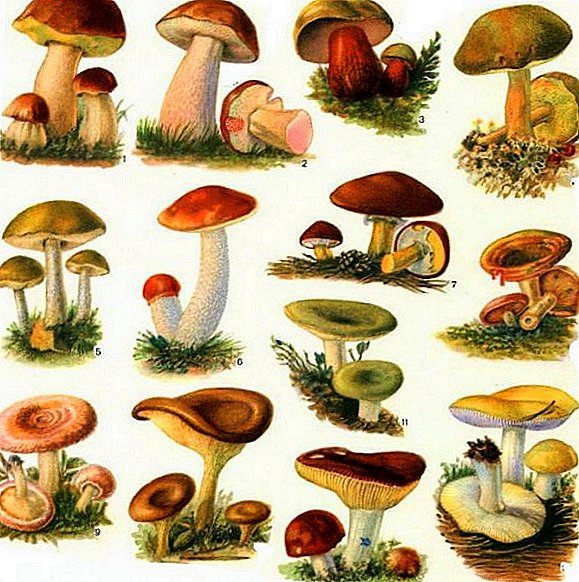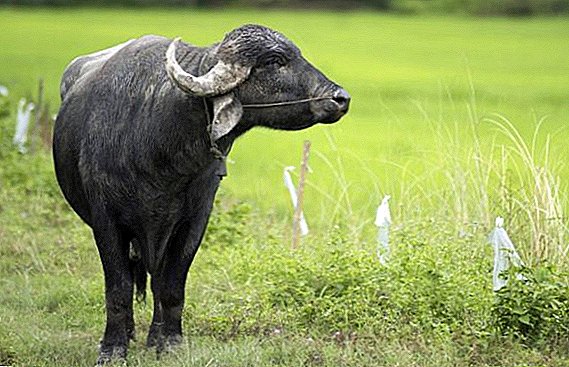 According to ancient frescoes and rock paintings, among the very first animals that were tamed by people were buffaloes, distinguished by tremendous strength and impressive size. Since ancient times, they have been used in the cultivation of the land as a force for importation, and they also ate their meat and milk.
According to ancient frescoes and rock paintings, among the very first animals that were tamed by people were buffaloes, distinguished by tremendous strength and impressive size. Since ancient times, they have been used in the cultivation of the land as a force for importation, and they also ate their meat and milk.
Today, the Asian (Indian) water buffalo can be called the bright representative of this species. If you still do not know anything about this giant, then this article is designed to introduce you to it.
Appearance
The Asian water buffalo is a hoofed member of the sub-family of bulls of the horned family, and is rightly considered one of the largest ruminant mammals on the planet. This powerful animal in its natural environment can live for more than 25 years and has the following external features:
- weight - from 900 kg to 1 t 600 kg;
- height at withers - about 2 m;
- torso length - 3-4 m (for females somewhat less);
- barrel body;
- divorced to the sides and curved towards the back, long, sickle horns, reaching 2 m in span;
- buffalo horns are smaller, straight;
- legs - high, up to 90 cm;
- tail - powerful and strong, 50-60 cm long;
- black, coarse wool.

Did you know? In different countries, water buffalo is treated differently: in Muslim Turkey, the water bull is counted as an unclean animal, and in Indian tribes there it is considered divine and used for sacrifices.
Who is bigger: water buffalo or African
Another large and strong bull is the African, which is not much inferior to its Asian congener:
- slightly shorter - 180 cm at the withers;
- weight - up to 1300 kg;
- the scope of the horns is 190 cm.
 Nevertheless, in endurance and ferocious nature, they are very similar and can stand up for themselves, not extinguishing themselves either before large predators, such as lions and tigers, or before man.
Nevertheless, in endurance and ferocious nature, they are very similar and can stand up for themselves, not extinguishing themselves either before large predators, such as lions and tigers, or before man.A close relative of the buffalo is the bull. Find out what the bull horns are for and how the bull horns are used as a drinking container.
Area of distribution and habitat
The name "Indian" and "Asian" gives out the territorial affiliation of the buffalo. These large mammals are found in the following areas:
- in Ceylon,
- in some regions of India,
- in Thailand,
- Bhutan
- Indonesia
- Nepal,
- Cambodia
- Laos.
 Water bulls are also found on the European and Australian continents. Domesticated individuals are more common and breed well in captivity due to isolation from wild conditions.
Water bulls are also found on the European and Australian continents. Domesticated individuals are more common and breed well in captivity due to isolation from wild conditions.
Important! In agriculture, experts recommend using water buffalo manure as a fertilizer rich in nutrients and minerals. Its use contributes to the rapid recovery of sprouts in the habitats of these animals.
Lifestyle, temper and habits
Despite their power and strength, buffaloes are cautious and prudent animals and avoid unnecessary contact with people. If human settlements are close by, bulls change their way of life to nightlife. The name "water buffalo" itself speaks of their habitat. Here are some of their habits:
- Most of his life the bull spends in the waters, which are his native element: in rivers, swamps, lakes, ponds. The animal loves almost completely submerged in water, leaving only the head with its majestic horns on the surface. This is a good way to escape the heat and the parasites.
- On land, it prefers to be in deciduous and evergreen forests with sparse stand, without dense thickets, where water bodies are located nearby.
- In open areas, animals rarely appear, only in search of food.
- In mountainous terrain, buffaloes can rise to an altitude of over 2500 meters.
- Animals live in herds of 10-12 heads: 1-2 males, 4-6 females with cubs and grown young. It is also possible to combine family herds in large groups.
- The head of the herd is usually the oldest and most experienced buffalo: during the movement she can be in front as a leader or close the retreat.
- The female leader warns the herd about the threat of a piercing snort, after which her wards should stop and stand still.
- After the danger has been determined, the buffaloes will occupy the battle order, but they will never attack first: they treat other animals peaceably and do not like to enter into conflicts, but prefer to quietly retire to the thicket of the forest.
- If the conflict could not be avoided, then the bull can attack the uninvited guest in a special way: by striking one horn, he is able to throw the enemy back a considerable distance.
- Elderly buffaloes usually live like hermits due to the fact that closer to old age their character deteriorates significantly and they become more aggressive than young individuals. Sometimes there have been cases of elderly lonely buffalo attacking people.


Important! In no case should one approach a buffalo with a calf at a very close distance: at first, mother is very careful and always ready to protect her baby.
What do buffaloes eat in the wild?
In addition, water reservoirs help buffaloes to withstand high temperatures, they are also a source of food for them: up to 70% of the food of buffaloes is in the water, the rest are on the shore. The water buffalo diet includes:
- grass of meadows and fields;
- plant leaves;
- young shoots;
- bamboo sprouts;
- shrub greens;
- seaweed;
- marsh grasses.

Breeding
Below we provide information related to the principles of reproduction of the Asian buffalo:
- The Indian bull in its natural habitat does not have a specific season for rutting and calving. But most often it occurs from the end of autumn to the middle of spring (November-April). This is due to the fact that animals live in warm climatic conditions and are able to conceive at different times of the year.
- The sexual maturity of animals comes in two or three years.
- During the rut period, young single males form a temporary herd. The male makes a loud summoning sound, similar to the roar of a deer, which is heard within a radius of one to two kilometers.
- Males arrange fights, during which they demonstrate their strength, but do not cause serious injuries to each other.
- A female ready for mating spreads a special smell that attracts males and gives them a signal to mate. After that, it is impregnated by a male who has achieved location.
- Pregnancy in water buffalo proceeds for 9-10 months.
- With the onset of labor, the buffalo retires into the undergrowth, and the two of them already return to the herd with the baby.
- Usually, a female has one fluffy calf with a red color and a weight of 40 to 50 kg, which the mother carefully licks and lifts on legs.
- The calf is with mother for 6-9 months, all the while feeding on its milk. At the end of this period, the baby partially switches to independent feeding, although the mother continues to feed him until one year of age.
- During the 3-year period, male calves are kept in the parent herd, and after that they establish their family flocks. Females remain in the maternal herd for life.
- Each female is settled once every two years.

Did you know? Buffalo milk is used to prepare the original Italian mozzarella cheese.
Population and conservation status
Today, for the most part, water buffaloes reside in human protected areas. In India, the habitats of wild bulls are completely tied to parks of national importance (for example, Kaziranga National Park in Assam), where hunting is strictly regulated. The same situation has developed on the island of Ceylon. In the countries of Bhutan and Nepal, the number and range of the Indian bull are constantly decreasing. The reason for this - the reduction of the area of the natural habitat due to human activity. Another serious threat to the existence of water buffalo is their constant crossing with their domestic counterparts, which leads to a loss of purity of the gene pool.  In conclusion, we emphasize that today the population of these magnificent animals is preserved thanks to their successful reproduction and the conservation efforts of humans.
In conclusion, we emphasize that today the population of these magnificent animals is preserved thanks to their successful reproduction and the conservation efforts of humans.












